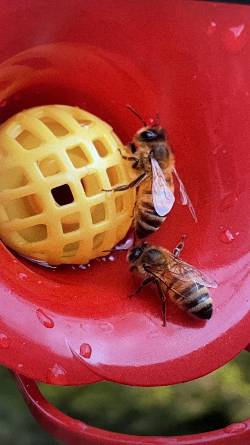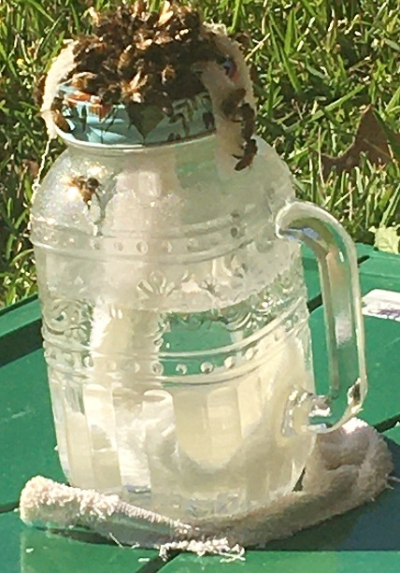Bees on Hummingbird Feeders

I love feeding the hummingbirds and watching them as they flit around my backyard in part because their attitude and spunk despite their small size along with their colors. While I love feeding the hummingbirds, I’m less thrilled about the wasps and bees that may frequent my feeders. While the insects usually are only a nuisance to me when I’m trying to fill the feeders or work in that area, occasionally some wasps might become territorial and chase the hummingbirds away from the feeders. I usually ignore the insects unless they become too big of an issue but there are some instances where I do feel the need to act. Bees and wasps are usually attracted to the feeders in late summer or into fall when other nectar sources are not as plentiful however in times of drought or hot weather they can also be attracted to the feeders. Bees can usually be discouraged from coming to the feeders by removing them for three to four days till they find new nectar sources but this method doesn’t always work on wasps. Another way to keep the insects from getting into the feeder is by using bee guards similar to the photo on the left. The cages allow hummingbirds with their longer beak and tongue to still feed while keeping the bees and wasps with their shorter mouth parts away from the feeder. Both of these methods involve excluding the bee from the feeder. Another way to keep bees and wasps from vising your feeder is to provide nectar sources for the insects in the form of flowering plants throughout your landscape so they have adequate amounts of food available. You could also feed the bees by making a homemade bee feeder similar to the photo on the right. Take a mason jar of any size then poke holes in the lid of the jar to allow for a wicking material to be pulled through. Any material will work for these wicks but a wider material to allow more space for the bees to land would work best. Fill the jar with the same sugar water that you put in your hummingbird feeder and set the jar in a location away from your hummingbird feeders or places where you like to sit and let the bees find it. This feeder is easier for the bees to access and is attractive to all types of bees. Hopefully one of these ideas will help you enjoy your hummingbird feeders all summer long without hurting any bees in the process.
homemade bee feeder similar to the photo on the right. Take a mason jar of any size then poke holes in the lid of the jar to allow for a wicking material to be pulled through. Any material will work for these wicks but a wider material to allow more space for the bees to land would work best. Fill the jar with the same sugar water that you put in your hummingbird feeder and set the jar in a location away from your hummingbird feeders or places where you like to sit and let the bees find it. This feeder is easier for the bees to access and is attractive to all types of bees. Hopefully one of these ideas will help you enjoy your hummingbird feeders all summer long without hurting any bees in the process.

